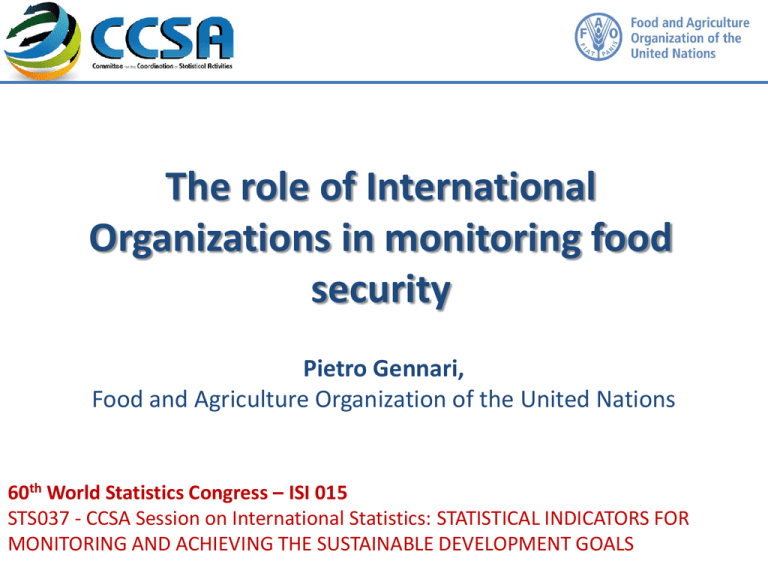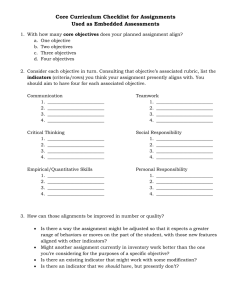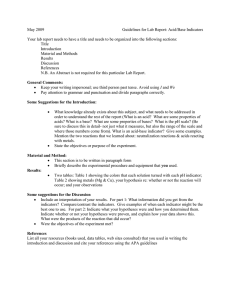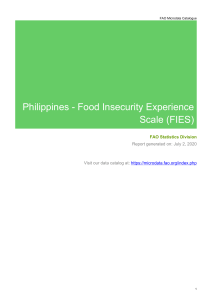The role of International Organizations in monitoring food security Pietro Gennari,
advertisement

The role of International Organizations in monitoring food security Pietro Gennari, Food and Agriculture Organization of the United Nations 60th World Statistics Congress – ISI 015 STS037 - CCSA Session on International Statistics: STATISTICAL INDICATORS FOR MONITORING AND ACHIEVING THE SUSTAINABLE DEVELOPMENT GOALS Background • Global Monitoring of development outcomes by International Organizations (IOs) mandated by member countries • Traditional monitoring role of IOs: • Contribute to define metrics/indicators • Develop methods, standards and tools for data collection • Provide technical support to countries for their implementation • Disseminate global databases, ensuring international comparability of indicators • Produce annual report on progress • When IOs cannot rely on official sources may use non-official sources to ensure data harmonization and to fill data gaps (CCSA) • IOs may launch direct data collections to produce indicators not yet covered by official statistics (SQAF and proper governance needed) FAO mandate on Agriculture & Food Security • Article 1 FAO Constitution: The Organization shall collect, analyse, interpret and disseminate information relating to nutrition, food and agriculture • Six editions of the World Food Survey from 1946 to 1996 • 1996 FAO World Food Summit set the global target to halve the number of hungry people by 2015 • Indicator selected: Prevalence of Undernourishment (PoU) • State of Food Insecurity in the World (SOFI) published yearly since 1999 • MDGs - Target 1.C: Halve, between 1990 and 2015, the proportion of people who suffer from hunger • PoU one of the 2 official MDG Indicators to monitor 1.C • Progress at global, regional and country level reported in SOFI and in the Global MDG Report From the MDGs to the SDGs SDGs - Goal 2: End hunger, achieve food security and improved nutrition, and promote sustainable agriculture. 5 multidimensional targets and 3 Means of Implementation On many SDG 2 targets there are no official statistics produced at country level: new indicators needed Need of new indicators also to respond to new data requirements E.g. target 2.1: replacing the PoU as the focus is on food access, not on hunger Some indicators produced outside of the national statistical system Need to bring back the ownership to countries (e.g. NSO to validate the data) Target 2.1: Limitations of the PoU • Target is universal, not limited to developing countries • PoU producing information only for developing countries • Target is ambitious: Eradicating, not halving hunger • 5% threshold for the PoU is too high • Not only hunger, but food access for all • Food availability is the main component of the PoU • Need to disaggregate at sub-national level (vulnerable groups and geographical areas) • PoU available only at the national level • Need for real-time assessment • PoU based on 2-3 year old data The “Voices of The Hungry” Project • New indicator of food access for global and national monitoring required by SDG Target 2.1 • Existing only in few countries. Global Monitoring cannot be based on national sources in the short-term • For the 1st time FAO to produce a global food access indicator through direct data collection (Voices of the Hungry Project) • Established the Food Insecurity Experience Scale (FIES), a metric for the severity of food insecurity for households or individuals • Since 2014 annual FIES estimates for about 150 countries, through the Gallup World Poll • Technical assistance provided to countries to introduce the FIES in national household surveys and eventually take over 6 The VoH project: main benefits • It provides a direct measure of people’s ability to access food • Enables assessment of the depth of food insecurity (mild, moderate, or severe) => can be used in developed countries • A sound methodology (Item-Response Theory) allows assessment of reliability and precision of the measures • A new metric for both households and individuals, thus proper analysis of gender related food insecurity disparities • The short questionnaire (9 yes/no questions) can be easily applied in virtually any household or individual survey • Rapid and low cost – enables timely global monitoring • Governments can use the indicator for targeted intervention, and monitoring/measuring impact of policies/programmes 7 The VoH project: Quality Assurance • Recognized world experts as member of the Scientific Advisory Committee and external scientific peer-review of methods • Rigorous procurement rules adopted for the selection of the data supplier; Quality assurance procedures for the validation of results • Methodology and data collection vehicle field-tested in 4 African countries in 2013 before application to a global scale • Open data policy: all micro-data and methodology publicly available, including open source software • Available national data on similar experience-based scales are calibrated against the global FIES (e.g., US, Canada, Brazil, Mexico, Guatemala) and replace the GWP data • A parallel system of annual data collection at global level & periodic larger scale data collection at national level, using the same tool 8 Conclusions • IOs are mandated by member countries to monitor development outcomes. IOs support global monitoring in many ways (e.g. by providing internationally comparable Global Public Goods) • IOs may use of non-official data only for very compelling reasons, including to fill information gaps or meet emerging needs • Monitoring SDG2 requires the development of new indicators • For the 1st time FAO relies on direct data collection to produce a global indicator: FIES estimates available in about 150 countries for 2014 and 2015 (SDG baseline) • Rigorous quality assurance procedures and country consultation applied • Ensure data harmonization & comparability across countries and regions • Methods, Software, linguistic and cultural adaptation of the questionnaire, technical assistance provided to countries for eventual national handover and sustainability • Long-term vision: FIES included in national HH survey in every country 9



